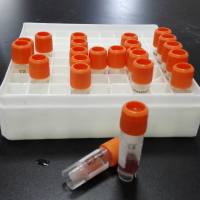In Vitro Drug Metabolite Profiling Using Hepatic S9 and Human Liver Microsomes
互联网
526
Following oral administration to animals and humans, drugs are absorbed, transported via portal circulation to the liver, and metabolized primarily via this organ. In general, drugs are predominantly metabolized by the oxidation of parent drug, which is typically mediated by cytochrome P450 (CYP450) enzymes. To a lesser degree, flavin monooxidation (FMO), as well as the reduction or cleavage of the parent drug via enzymatic (i.e., esterase and amidase) or nonenzymatic hydrolysis, forms other phase I metabolites. Subsequent conjugation (phase II reaction) of the phase I metabolites can produce glucuronide, sulfate, glutathione, glycine, and acetate conjugated metabolites. In many cases, hepatic in vitro metabolism studies can yield valuable preliminary information on the in vivo metabolism of a compound of interest by the liver. Experimental in vitro hepatic systems using hepatocytes, 9000g supernatant (S9), and microsomal fractions are presently used to characterize the in vitro metabolism of xenobiotics. Following the incubation of drugs with either of the systems above, solvent or solid-phase extraction, radio-TLC (14 C/3 H-labeled drugs), high-performance liquid chromatography (HPLC) (radiolabeled or unlabeled), liquid chromatography/mass spectrometry (LC/MS), nuclear magnetic resonance (NMR), and derivatization (phenolic, alcoholic, carboxylic, and/or amino metabolites) techniques are commonly used to analyze and evaluate the metabolic stability of drugs (percentage of parent remaining), as well as to quantify, characterize, and identify drug metabolites and their derivatives. In this chapter, valuable in vitro methods using animal and human hepatic S9, as well as human liver microsomal fractions, and unique techniques for estimating and understanding metabolic stability, as well as profiling and identifying metabolites, will be discussed for use in drug discovery and drug evaluation phases of a drug’s development.









